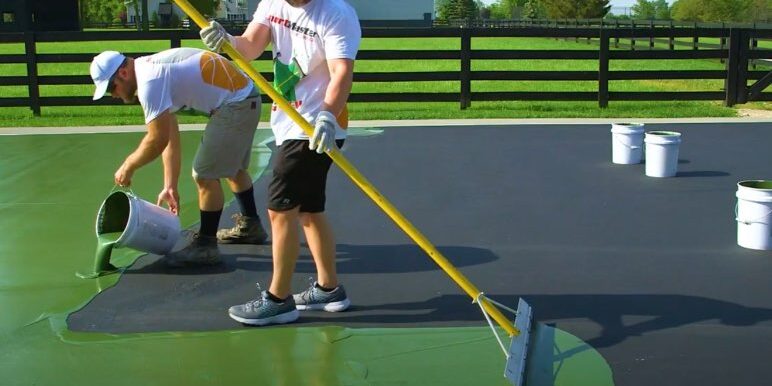Interior and Outside Pickleball Court Construction Solutions
Interior and Outside Pickleball Court Construction Solutions
Blog Article
Sustainable Practices in Pickleball Court Building And Construction You Ought To Know
As the popularity of pickleball remains to increase, so as well does the requirement for sustainable techniques in court construction. This method not only addresses environmental problems but also enhances the durability and performance of the courts. From selecting environmentally friendly materials to applying efficient water drainage and energy-saving illumination services, there are various approaches to think about. Yet, the impact of these techniques prolongs much past the court itself. Understanding how each component adds to an extra lasting future welcomes even more expedition right into the intricate balance in between leisure development and ecological stewardship.
Picking Eco-Friendly Products
Picking eco-friendly products is a vital action in the building of sustainable pickleball courts. The choice of lasting products not only decreases environmental impact yet additionally boosts the durability and efficiency of the court. Key materials include reused rubber for the surface, which supplies excellent longevity and shock absorption while drawing away waste from land fills.
Furthermore, making use of locally sourced products lowers transport emissions and supports regional economies. Pickleball court construction. As an example, using native woods for secure fencing and seating can provide a lasting visual while making sure resilience against the aspects.
Integrating permeable products for court foundations can additionally add to sustainability by enabling natural water drainage and lowering drainage. These choices not only protect local communities however likewise advertise much healthier play environments.
Efficient Drain Solutions
While the selection of green materials is important, executing reliable water drainage remedies is just as crucial for maintaining sustainable pickleball courts. Proper drain not only secures the court surface area from water damage yet likewise reduces disintegration and runoff, advertising ecological stability.
Efficient drain systems can include absorptive paving, which enables water to penetrate the ground rather than merging on the surface area. This lowers the probability of standing water, which can lead to mold and mildew and various other maintenance problems. In addition, including tactically put drainage networks and swales can direct excess water far from the court area, making sure a completely dry having fun surface and avoiding dirt erosion.
Utilizing native greenery in the landscaping around the courts can further enhance drainage by absorbing excess water and reducing overflow. These plants need less watering and promote biodiversity, lining up with lasting methods.
Additionally, it is important to consistently keep the water drainage system to guarantee its lasting effectiveness. This includes clearing up particles and surveillance for obstructions. By focusing on effective drain solutions, pickleball court contractors can dramatically contribute to the sustainability and durability of the facility, eventually benefiting both players and the atmosphere.
Energy-Efficient Lights Options
As the need for pickleball proceeds to expand, incorporating energy-efficient lights choices right into court style has come to be significantly important for sustainability. Traditional lights systems frequently take in excessive energy, contributing to higher functional expenses and ecological influence. Taking on modern-day, energy-efficient technologies is essential for both new constructions and improvements.
LED (Light Emitting Diode) lights attracts attention as a premier selection because of its longevity and energy financial savings (Pickleball court construction). Contrasted to traditional lighting, LEDs use roughly 75% much less power and can last as much as 25 times much longer, substantially decreasing maintenance expenses. In addition, the directional nature of LED illumination reduces light air pollution, guaranteeing that illumination is concentrated on the court instead than bordering locations.

Lasting Surface Alternatives
Discovering sustainable surface area choices for pickleball courts has gained traction among home builders and gamers alike. The focus on environment-friendly products not just aligns with the expanding environmental understanding yet also enhances the efficiency and longevity of the courts.
One popular alternative is the use of recycled rubber, which can be sourced from used tires. This material provides excellent shock absorption, lowering the threat of injuries for players while advertising sustainability. Furthermore, modular floor tiles made from recycled plastics offer another practical choice. These ceramic tiles are very easy to change and install, and their versatility permits different court setups.
Natural yard courts are likewise emerging as a lasting choice, promoting biodiversity and lowering the heat island impact. They require normal upkeep and water, which may not straighten with all sustainability objectives.

Water Conservation Techniques
One more effective technique entails the installment of rainwater harvesting systems. These systems keep and gather rainwater for usage in preserving court surfaces and landscape design. This method not only conserves safe and clean water however also minimizes reliance on metropolitan sources.
Moreover, using drought-resistant landscaping around the courts is crucial. Native plants call for less water and are much better adapted to regional environment conditions, hence decreasing general water intake. In addition, utilizing effective irrigation systems, such as drip irrigation, makes certain that water is provided straight to plant origins, reducing dissipation and waste.
Conclusion
Including lasting practices in pickleball court construction substantially contributes to ecological preservation and source effectiveness. By focusing on these techniques, the building of pickleball courts can straighten with broader ecological objectives while promoting durability and capability within neighborhoods.
As the appeal of pickleball continues to climb, so too does the requirement for lasting practices in court building.Selecting environment-friendly materials is a vital action in the building of lasting pickleball courts. By focusing on energy-efficient lights alternatives, pickleball court contractors can contribute to a much more sustainable future while meeting the needs of stakeholders and gamers alike.Incorporating sustainable surface options not official site just improves the performance of pickleball courts yet likewise leads the means for executing efficient water preservation i thought about this strategies.Including sustainable techniques in pickleball court construction substantially adds to environmental preservation and resource performance.
Report this page